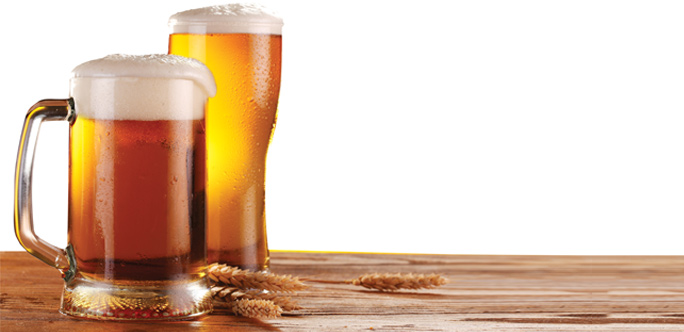Beer Basics
This time of year, we’re all doing a lot more entertaining, including serving drinks to our guests. If beer is your preference, you’re certainly not at a loss for selections. There are many different types of beer available now, so how do you know what kind of beer to serve? And what type of beer do you serve with certain types of food? I’ve recently attended several beer-pairings dinners, and learned there’s more to it than just cracking open a cold one.
Brewing Fundamentals
Beer is the world’s oldest and most widely consumed alcoholic beverage, and the third most popular drink overall after water and tea. It is produced by the brewing and fermenting of starches, mainly derived from cereal grains, such as malted barley. Most beer is flavored with hops, which add bitterness and act as a natural preservative. “The hops balance the sweetness of the malted barley,” says Brewmaster Beau Baden, Allentown Brew Works. “The longer the hops boil, the more bitterness you get.” According to Baden, it takes anywhere from two weeks to six months to make beer. “It may surprise your readers to learn that some Belgian Ales, which tend toward the tart side, can take up to two years to produce.”
Beer Styles
While there are about 80 styles, beer falls into two main categories – ales and lagers. Ale uses yeast that ferments at the top of the fermentation vessel, and typically at higher temperatures than lager yeast. This makes for a quicker fermentation period, such as a week or less. Ale yeast is known to produce by-products called esters, which are subtle “flowery” and “fruity” aromas. There are many types of ales, as they have their roots in different parts of the world. Ales are further broken down in to pale ale, stout and brown ale.
The word lager comes from the German word lagern which means “to store.” Lagers are brewed with yeast that ferments at the bottom of the vessel, at around 34 degrees F. They are often stored in cooler temperatures to mature. “Lagers take about a month or more to produce, and result in less by-products, so you get a cleaner, crisper taste,” says Chris Wilson, Head Brewer, Weyerbacher Brewing Co, Easton.
So how do you know which type is for you? “There is an unlimited range of flavors and colors with beer,” notes Wilson. “That’s one of the great things about beer. Colors range from a pale yellow to midnight black, which is completely opaque. The first step is to decide if you like a more malty beer, like a Guinness, or a hoppy beer, like a Pale Ale. If you prefer something light and crisp, I suggest a Heffenweisen.”
Beer Trends
“The historical trend we’ve noticed is that people today want a more full-bodied, flavorful beer,” says Wilson. “There’s no denying that the public is looking to get more flavor in their beer.” Wilson also noticed the explosion of smaller breweries. “Back in the 70s you had a handful of huge breweries, like Anheuser-Busch. Most of the beer you could easily get was yellow. The only beer with color was Yuengling. In the mid-80s, a movement started in California toward craft brewers. Today, there are hundreds of small, craft brewers like us, and we’re doing well, despite the economy. Sales are up about nine percent over last year. That’s pretty significant.”
Beer Pairings
There are some general guidelines chefs like to use when planning a beer pairings dinner, but it all comes down to what appeals to you most. Have fun with it, and experiment. Generally, the more hop bitterness a beer has, the livelier the meal needs to be to hold its own, such as a Leffe Blond with a bowl of chili. It’s also a good idea to pair sweet with sweet, and tart with tart. For example, you can pair a stout beer, which tends to be more bitter, with a bittersweet chocolate dessert. You don’t want the flavor of the food to drown out the flavor of the beer, and vice versa.
Chef Eric Stemp, owner of Baked in Emmaus, explains and offers up a sample beer-pairings dinner. “For the first course, I recommend pairing an ale that has a hoppy flavor with a shrimp lemongrass soup with coconut milk base and chilies. Hoppy beers tend to pair well with spicy dishes. The next course could be a lighter ale made with honey, paired with foie gras with macadamia nut gremulata and baked cherry gelee. The foie gras is a very rich dish, and the lighter ale cuts through with crispness and gives the course balance.”
“The beer for the entrée could be a very dark brown ale that has a caramel and chocolate flavor to it. I would pair it with an entrée to complement those heavy, rich flavors, such as a country boneless pork rib cooked in a sauce made from that dark beer.” The final course would be a dark, stout beer paired with a decadent chocolate dessert. “A more delicate dessert, such as something made with fresh fruit and meringue, would be overpowered by a heavy, stout beer.”
For More Information:
The Brewers Association: brewersassociation.org
Beer Advocate: beeradvocate.com
SOURCES:
Beau Baden, Allentown Brew Works, 812 W Hamilton St, Allentown: 570.561.9493
Eric Stemp, Baked, 228 Main Street, Emmaus, 610.966.6100.
Chris Wilson, Weyerbacher Brewing Co, 905-G Line Street, Easton: 610.559.5561





